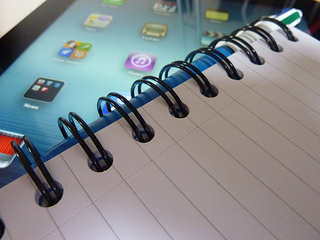
This is a guest post by Marc-André Lalande, a consultant with the RÉCIT Provincial Service in General Adult Education. It was originally published as part of the online newsletter Online PD Monthly.

photo by Sean MacEntee
Creative Commons License
Can you remember this? The first iPad was sold in April 2010; that’s only three and half years ago. I say “only” because these devices, the iPad as well as other tablets, are already somewhat ordinary today, part of the scenery. I recall very strong skepticism regarding the success of the iPad the first few months before and after its launch. “Who needs a big iPod touch?” many said. If you’d like to wax nostalgic, you’ll find some of these old remarks in this post by Thessaly La Force in The New Yorker (Arpil 5, 2010). You can also read how it made Steve Jobs feel in this Apple Insider piece: “Steve Jobs was ‘annoyed and depressed’ over initial reaction to iPad launch”.
Embracing the Once Shunned
Today, some schools and centres are very proud to announce their “one tablet per pupil” programs. The real question for me is this: “Are we looking for a brand new tool to do the same old school?” I hope that we will be leveraging the tablet for the great advantage of having ubiquitous access to information in all its glorious forms more than for apps that offer electronic versions of what used to be done in activity books. For that to happen, I believe we need to change a few things about our vision of school and of pedagogy. But change is scary…
Change Is Scary
Marc-André Lalande, 1:58
A short, light-hearted conversation starter on the place of tablets in the classroom.
Connection Is Power Is Connection
The real power of the tablet lies in having it always available so learners can look up info as need be, squiggle notes, take pictures and movies, communicate, create, collaborate, you know, the whole kit and caboodle of what really matters for learning. In my view, having the tablets sit in a cart until the teacher decides what activity they’re going to be used for, everybody at the same time, defeats the purpose of a tablet. And that makes access to Wi-Fi a priority before buying anything else… unless you want to move your class to a coffee shop.
You Want Your Own
If you already have one of your own, you know that a tablet isn’t really designed to be shared. You’re logged in to everything all the time and all your personal media is accessible as you flick the thing open.
Principals often ask me how they should go about managing their tablets in their school or centre. My answer is “Don’t”. Let the students and staff bring their own and lend as many as you can to those who can’t afford one… long term; let them take it home. Get a waiting list going if need be. But I’ll bet you’ll see a change in Christmas lists happening in no time. The best thing is to have learners and staff manage their own device so they can install the apps they want and need; having someone else manage your tablet is a huge inconvenience … so avoid it if you can.
On BYOD and how the classroom is changing
Sam Gliksman: BYOD – Bring your own device from EDtalks on Vimeo.
So there you go… All set and ready for change: a change in how we use technology and when we use it, a change in device management, and most importantly, a change in pedagogy. So yes, all of this can seem a little overwhelming at first. Change is scary. But the status quo… now that is truly terrifying!
**************
You can find out more from Marc-André on his PD Pinterest collection.







